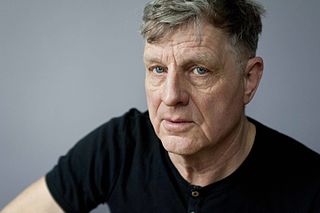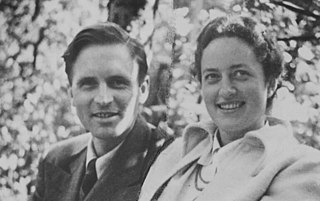Related Research Articles

Emil Nolde was a German-Danish painter and printmaker. He was one of the first Expressionists, a member of Die Brücke, and was one of the first oil painting and watercolor painters of the early 20th century to explore color. He is known for his brushwork and expressive choice of colors. Golden yellows and deep reds appear frequently in his work, giving a luminous quality to otherwise somber tones. His watercolors include vivid, brooding storm-scapes and brilliant florals.
Das Erste is the flagship national television channel of the ARD association of public broadcasting corporations in Germany. Das Erste is jointly operated by the nine regional public broadcasting corporations that are members of the ARD.

The Städel, officially the Städelsches Kunstinstitut und Städtische Galerie, is an art museum in Frankfurt, with one of the most important collections in Germany. The museum is located at the Museumsufer on the Sachsenhausen bank of the River Main. The Städel Museum owns 3,100 paintings, 660 sculptures, more than 4,600 photographs and more than 100,000 drawings and prints. It has around 7,000 m2 (75,000 sq ft) of display and a library of 115,000 books.

The Berlin Secession was an art movement established in Germany on May 2, 1898. Formed in reaction to the Association of Berlin Artists, and the restrictions on contemporary art imposed by Kaiser Wilhelm II, 65 artists "seceded," demonstrating against the standards of academic or government-endorsed art. The movement is classified as a form of German Modernism, and came on the heels of several other secessions in Germany, including Jugendstil and the Munich Secession.

Rainer Fetting is a German painter and sculptor.

The Hörspielpreis der Kriegsblinden, also known as the Kriegsblindenpreis is the most important literary prize granted to playwrights of audio plays written in the German language. The award was established in 1950 by the Bund der Kriegsblinden Deutschlands e.V. (BKD), a German organization for soldiers and civilians blinded during war, whether from working with munitions or explosives or from a bomb attack or while in flight from an attack.

Veronica Carstens was the wife of the German President Karl Carstens.

Matthias Laurenz Gräff is an Austrian-Greek academic painter, private historian, politician, political activist and co-founder and organizer of the non-partisan platform Dialog im Kamptal. Since 2013 Gräff has served as chairman of the worldwide Family Association Gräff-Graeff and since 2024 as the official Representative of the NEOS parliamentary party for Greece.

The Sin is an 1893 painting by the German artist Franz Stuck. Stuck created twelve known versions of the painting. Some of these can be viewed at the Neue Pinakothek, in Munich, the National Gallery, in Berlin, the Galleria di arte Moderna, in Palermo, the Frye Art Museum, in Seattle, and at the Villa Stuck, in Munich, where it is enshrined in the artist's Künstleraltar. It depicts the nude Eve with a large serpent wrapped around her body. In the upper right corner is a bright field, while the rest of the surroundings are dark.
Today the term South Seas, or South Sea, most commonly refers to the portion of the Pacific Ocean south of the equator. The term South Sea may also be used synonymously for Oceania, or even more narrowly for Polynesia or the Polynesian Triangle, an area bounded by the Hawaiian Islands, New Zealand and Easter Island. Pacific Islanders are commonly referred to as South Sea Islanders, particularly in Australia.
The Flensburg stabbing incident occurred on 30 May 2018, when a female police officer traveling off-duty on a high-speed train in Flensburg, Germany, was stabbed by an Eritrean man. He next attacked a male passenger who came to her aid. The perpetrator was then shot and killed by the police officer. The motive behind the stabbing was not clear. The man was a refugee, who had arrived in Germany in September 2015 and had a history of violent altrications. The incident was not considered terrorism.

Elisabeth Charlotte Motschmann is a German journalist and politician of the Christian Democratic Union (CDU) who has been serving as a member of the Bundestag from 2013 until 2021. In parliament, she was her party's spokeswoman on media policy.

Fox, also known as Blue and Black Fox or Blue Fox, is an oil on canvas painting by Franz Marc, from 1911. It is part of the collection of the Von der Heydt Museum in Wuppertal.

Katrin Suder is a German physicist and management consultant who served as State Secretary in the Federal Ministry of Defense in the government of Chancellor Angela Merkel from 2014 to 2018.

Heinrich Arnhold, in full Heinrich Gustav Arnhold was a German banker, collector, patron and esperantist.

The Portrait of a Man in a Wide-Brimmed Hat is a work by the Dutch Golden-Age artist Frans Hals. It was painted in about 1625–1635 and hangs in the Herzogliches Museum, part of the Friedenstein Palace complex at Gotha, Germany. It was stolen in 1979, recovered in 2019, and restored in 2020–2021.

Archers is an oil-on-canvas painting by German painter Ernst Ludwig Kirchner, created in 1935–1937, at his Swiss home town of Davos. It belongs to his last phase, in which he abandoned the Expressionism of his earlier work. The painting depicts three people engaged in the sport of archery. On the back it bears the signature EL Kirchner. The painting is part of the collection of the Kirchner Museum Davos.

The Nolde Stiftung Seebüll, also known as Stiftung Seebüll Ada und Emil Nolde, in English, the Nolde Foundation Seebüll, or the Seebüll Ada and Emil Nolde Foundation, is a foundation established in 1956, who is the sponsor of an art museum in Seebüll, in Schleswig-Holstein, dedicated to the life and works of the German painter Emil Nolde. The museum was opened in 1957, after Nolde's death, by the Seebüll Ada and Emil Nolde Foundation.
The Life of Christ is a nine-part polyptych by the German Expressionist painter Emil Nolde, produced in 1911–1912. It is one of the main works of the artist's Christian-inspired religious paintings. It is held at the Nolde Stiftung Seebüll.
Dance Around the Golden Calf is an oil-on-canvas painting by German-Danish painter Emil Nolde, created in 1910. It is held at the Pinakothek der Moderne, in Munich.
References
- ↑ "Nach fast 40 Jahren: Verschollenes Nolde-Gemälde wieder aufgetaucht", in Spiegel Online, 26 November 2018 (German)]
- ↑ "Claudia Christophersen über das Sonnenblumen-Bild von Emil Nolde", NDR, retrieved on 1 December 2018 (German)
- ↑ Werner Haftmann, Emil Nolde, Cologne, 1959, p. 112 (German)
- ↑ Carsten Germis, "Wundersame Rückkehr: Kunstkrimi um gestohlene "Sonnenblumen“ von Emil Nolde", in FAZ.NET, 25 November 2018 (German)
- ↑ Carsten Germis, "Wundersame Rückkehr: Kunstkrimi um gestohlene "Sonnenblumen“ von Emil Nolde", in FAZ.NET, 25 November 2018 (German)
- ↑ "Claudia Christophersen über das Sonnenblumen-Bild von Emil Nolde", NDR, retrieved on 1 December 2018 (German)
- ↑ "Gestohlenes Nolde-Gemälde wieder aufgetaucht", NDR, retrieved 1 December 2018 (German)